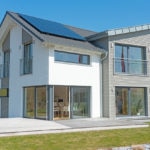Luis Alonso's commitment to innovate in architecture and put a 2000 year standstill in the past
Luis Alonso (Madrid, 1979) is a doctor of architecture and coordinator of the Technical Committee for the Standardization of Intelligent Cities for the Spanish Association of Standardization and Certification (AENOR)'s Energy Efficiency in Buildings. He is convinced that transferring technologies from other disciplines to building will modernize it and will adapt to people's current needs. This is why he recently created Laap Technology and collaborates with MIT's CityHome project. The invention of a new super insulating product, F2TE3, inspired by the NASA spacecrafts that go to Mars, earned him recognition from the MIT Technology Review Innovators under 35 award in Spain in 2013.

Architecturally speaking, how are we like the Romans?
Inside, our homes are exactly the same at those from the Roman era. If you compare how a room was back then to how it is now, 90% of the materials are the same: concrete, wood and ceramic. However, our way of living and our technologies are 2000 times more advanced. Vehicles have undergone a completely different evolution: vehicles nowadays share almost no materials with the Roman quadrigas: not the horses or the wood. This is because architecture has been on hold for the last 2000 years.
The Necessary Architecture Congress, held in June, pointed out the need to build more livable cities. Do you think that we are in a time of architectural change?
Rather, we are in a time of architectural silence, because although we know that we can't carry on the way we're going, there are no new proposals. We mustn't forget that architecture should have a community aspect and although it leans more towards more energy efficient cities, it leaves out this essential aspect.
How should a city be?
It has to be ecologically, economically and socially maintainable. There are an increasing number of urban regulations for the first two pillars, but the social rules that are coming about are very disorientated. The city has to move according to the new social pulses that require shared spaces. To do so, we can look toward new materials and technologies.
F2TE3 makes me think more of the name of a robot than that of a new material.
I like the fact that the system has a comic feel to it, because they're very important to me, as they allow the possibility of proposing futures without any critical or economic weight. Although in fact F2TE3 means Transparent Façade (Fachada Transparente) but expressed as if it were a mathematical formula.
What is F2TE3?
It's a transparent panel, like a sandwich, in which the slices of bread are transparent methacrylate and the ham is the main material, airgel, which is crystallized silica and which is the isolating element. A vacuum is produced inside these elements, which provides the super isolation. The greatest challenge is to maintain the vacuum inside the panel, because all the materials are permeable to air. We've manage to give it a 50 year life, during which the material will be super isolating. After that time, the isolation will be more or less equivalent to a 20 centimeter wall instead of a 30 centimeter wall, which will still be a good isolation.
What will this material be used for?
It could replace any type of enclosure - walls, façades, doors and windows. 3.5 cm thick, it isolates 0.6% more than a 30 or 40 centimeter wall because it uses new technologies such as the vacuum chamber and new materials like monolithic airgel. It also saves space: in a 150 m2 home, changing the traditional structures for mine would give you an extra 14 m2, because it is so thin.

Luis Alonso, building efficiency expert and defender of modernizing architecture
Although its main application is in large glass buildings.
When analyzing how to sell the material, I realized that the market it could really compete in is that of the curtain walls, which are the glass façades of buildings, such as the Space Towers (Madrid). The systems currently being used - with double or triple glazing, are not energy efficient, and mine, which provides the same benefits because it's transparent, isolates between 20% to 30% more. Plus it's between one and four times cheaper.
Where did the idea for this material come from?
The main component of F2TE3, the airgel, is a material that's been used by NASA as isolation since the 30s in space missions to Mars. A few years ago it was very expensive because, although it's based on silica, which is cheap, the process wasn't. Thanks to the Seventh Framework Program financing research to reduce the cost, it now costs between 18 and 20 Euros per m2.
When will we see this material on the street?
If we manage to get funding, it could be sold in three years.
Are you researching other new architectural elements at your company, LAAP Technology?
This company was founded recently due to my personal interest in transferring technology from fields such as automotive, aeronautics and space to building. For example, home automation is at stage 1.0, where the user has to decide everything. We are trying to make the buildings sufficiently intelligent so as to self-adjust based on the big data they receive. This means them having external sensors and knowing whether they need to turn on the heating or the air conditioning or close the blinds.
What will be your contribution to the Massachusetts Institute of Technology (MIT) CityHome project?
The purpose of the time I'll be spending at MIT (USA) is in line with what I mentioned earlier: propose the systems used in other industries that can be applied to the project. I believe that I can apply IT in building in the versatile spaces being worked on.
In the future, will we be talking about the F2TE3 bubble instead of the brick bubble?
I don't think we'll be seeing that, although it would be nice. Not because of the bubble, but because of the evolution of architecture. If this system could be a starting point so that other technologies can be incorporated into construction, it would be great.